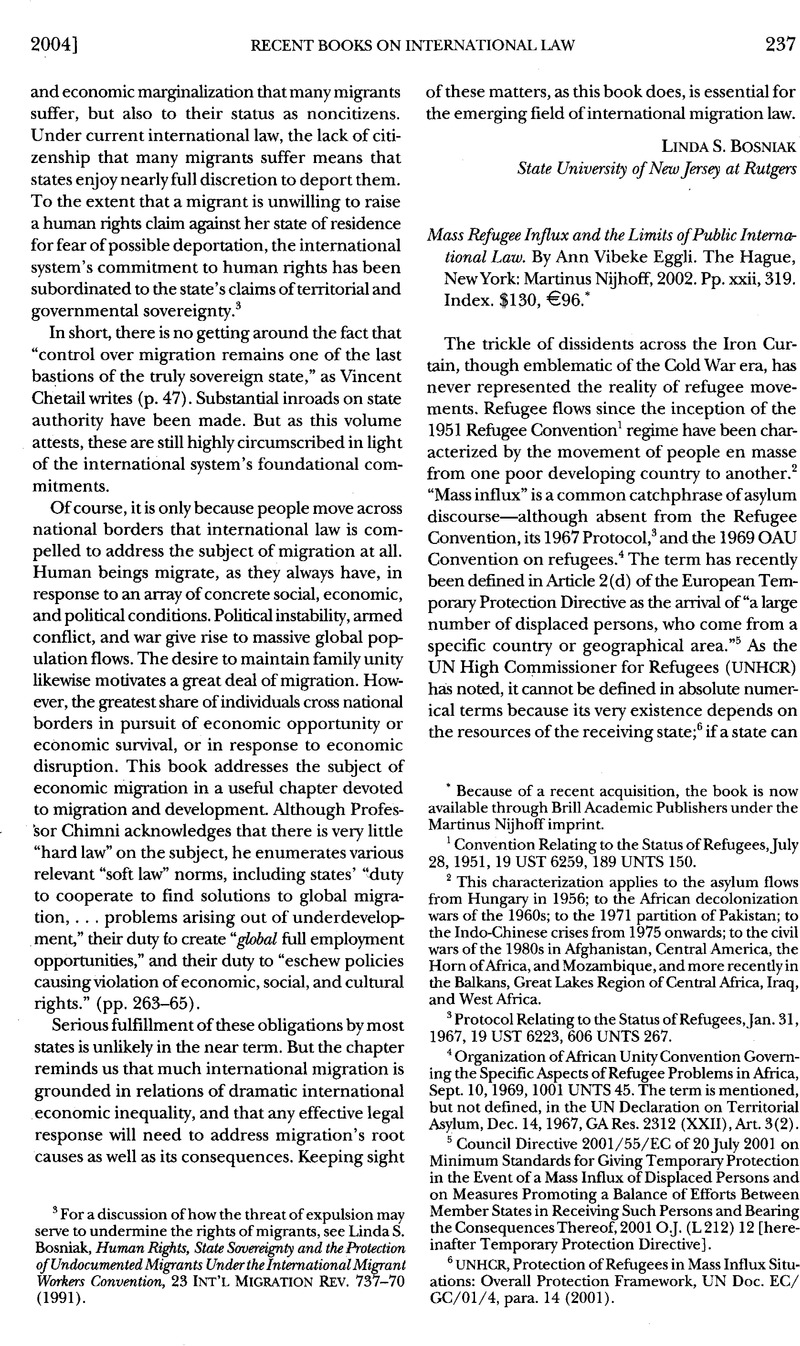No CrossRef data available.
Published online by Cambridge University Press: 27 February 2017

* Because of a recent acquisition, the book is now available through Brill Academic Publishers under the Martinus Nijhoff imprint.
1 Convention Relating to the Status of Refugees, July 28, 1951, 19 UST 6259, 189 UNTS 150.
2 This characterization applies to the asylum flows from Hungary in 1956; to the African decolonization wars of the 1960s; to the 1971 partition of Pakistan; to the Indo-Chinese crises from 1975 onwards; to the civil wars of the 1980s in Afghanistan, Central America, the Horn of Africa, and Mozambique, and more recently in the Balkans, Great Lakes Region of Central Africa, Iraq, and West Africa.
3 Protocol Relating to the Status of Refugees, Jan. 31, 1967, 19 UST 6223, 606 UNTS 267.
4 Organization of African Unity Convention Governing the Specific Aspects of Refugee Problems in Africa, Sept. 10, 1969, 1001 UNTS 45. The term is mentioned, but not defined, in the UN Declaration on Territorial Asylum, Dec. 14, 1967, GA Res. 2312 (XXII), Art. 3(2).
5 Council Directive 2001/55/EC of 20 July 2001 on Minimum Standards for Giving Temporary Protection in the Event of a Mass Influx of Displaced Persons and on Measures Promoting a Balance of Efforts Between Member States in Receiving Such Persons and Bearing the Consequences Thereof, 2001 O.J. (L212) 12 [here-inafter Temporary Protection Directive].
6 UNHCR, Protection of Refugees in Mass Influx Situations: Overall Protection Framework, UN Doc. EC/GC/01/4, para. 14(2001).
7 UNHCR, Commentary on the Draft European Union Directive on Temporary Protection in the Event of a Mass Influx 3 (2000), at <http://www.ecre.org/eu_developments/temporaiy%20protection/index.shtml>.
8 Statute of the Office of the United Nations High Commissioner for Refugees, GA Res. 428 (V) (Dec. 14, 1950).
9 But see European Union measures on temporary protection, supra note 5, and on complementary (or subsidiary) protection, infra note 11.
10 Cartagena Declaration on Refugees, Nov. 22, 1984, Annual Report of die Inter-American Commission on Human Rights, OAS Doc. OEA/Ser.L/V/H.66/doc.l0, rev. 1, at 190-93 (1984-85).
11 Temporary Protection Directive, supra note 5; Proposal for a Council Directive on Minimum Standards for the Qualification and Status of Third Country Nationals and Stateless Persons as Refugees or as Persons Who Otherwise Need International Protection, COM(2001)510 final (Sept 12, 2001). Note that the latter directive applies not to situations of mass influx, but to individual asylum applicants deemed to fall outside the Refugee Convention but who are nonetheless in need of international protection (described as “subsidiary protection”).
12 Hyndman, Jennifer & Bo, Viktor-Nylund, UNHCR and the Status of Prima Facie Refugees in Kenya, 10 Int'l J. Refugee L. 21, 46 (1998)Google Scholar.
13 Sherman, A. J., Island Refuge: Britain and Refugees from the Third Reich 1933-1939, at 187, 228, 258 (2d ed. 1994) (citing, respectively, 341 PARL. DEB., H.C. (5th ser.) (1938) 1931-32; 345 Parl. Deb., H.C. (5th ser.) (1939) 3043-87; War Cabinet Conclusions 112 (39) 5 (1939) CAB 65/2)Google Scholar; Vernant, Jacques, The Refugee in the Post-War World 28 (1953)Google Scholar.
14 See also Lauterpacht, Elihu & Bethlehem, Daniel, The Scope and Content of the Principle of Non-Refoulement: Opinion, in Refugee Protection in International Law: Unhcr's Global Consultations on International Protection 87 (Feller, Erika, Türk, Volker, & Nicholson, Frances eds., 2003)Google Scholar.
15 Convention Against Torture and Other Cruel, Inhuman or Degrading Treatment or Punishment, Dec. 10, 1984, S. Treaty Doc. No. 100-20 (1988), 1465 UNTS 85.
16 International Covenant on Civil and Political Rights, Dec. 16, 1966, S. Exec Doc. 36 E, 95-2, (1978), 999 UNTS 171.
17 Article 33(2) provides:
The benefit of the present provision [prohibiting refoulement] may not, however, be claimed by a refugee whom there are reasonable grounds for regarding as a danger to the security of the country in which he is, or who, having been convicted by a final judgement of a particularly serious crime, constitutes a danger to the community of that country.
18 American Convention on Human Rights, Nov. 22, 1969, 1144 UNTS 123.
19 Convention for the Protection of Human Rights and Fundamental Freedoms, Nov. 4, 1950, 213 UNTS 221.
20 Hartman, Joan F. Derogation from Human Rights Treaties in Public Emergencies—A Critique of Implementation by the European Commission and the Court of Human Rights and the Human Rights Committee of the United Nations, 22 Harv. Int'l. L.J. 1, 17 (1981)Google Scholar.